The Eczema Relief Creams Market is expected to record a valuation of USD 5,203.4 million in 2025 and USD 12,403.7 million in 2035, with an increase of USD 7,200.3 million, which equals a growth of 138% over the decade. The overall expansion represents a CAGR of 9.1% and more than a 2X increase in market size.

Eczema Relief Creams Market Key Takeaways
| Metric | Value |
|---|---|
| Eczema Relief Creams Market Estimated Value in (2025E) | USD 5,203.4 million |
| Eczema Relief Creams Market Forecast Value in (2035F) | USD 12,403.7 million |
| Forecast CAGR (2025 to 2035) | 9.1% |
During the first five-year period from 2025 to 2030, the market increases from USD 5,203.4 million to USD 8,033.8 million, adding USD 2,830.4 million, which accounts for 39% of the total decade growth. This phase records steady adoption in pharmacies/drugstores and e-commerce channels, driven by the need for accessible OTC corticosteroid creams and emollient-based barrier repair solutions. Barrier repair creams dominate this period, capturing over 53% of functional applications, as demand rises among infants and sensitive skin users.
The second half from 2030 to 2035 contributes USD 4,369.9 million, equal to 61% of total growth, as the market jumps from USD 8,033.8 million to USD 12,403.7 million. This acceleration is powered by widespread consumer adoption of fragrance-free, dermatologist-tested, and steroid-free claims, coupled with increased reliance on adjunctive therapies such as colloidal oatmeal and probiotics. By 2035, fragrance-free formulations account for nearly 57% of USA sales, while barrier-repair creams in China capture 54.6% share. Brand competition intensifies, with leading players like CeraVe, Aveeno, and La Roche-Posay expanding retail and e-commerce penetration.
From 2020 to 2024, the eczema relief creams market expanded steadily, supported by rising prevalence of eczema in infants and adults, coupled with increased awareness of skincare solutions. During this period, the competitive landscape was dominated by OTC emollients and corticosteroid creams, accounting for the majority of sales. Leading brands such as Aveeno and Eucerin emphasized dermatologist-recommended barrier-repair formulations. Competitive differentiation was driven by clinical validation, safety claims (fragrance-free, hypoallergenic, steroid-free), and consumer trust in heritage skincare brands. Natural adjunctive therapies such as colloidal oatmeal-based products gained traction, while probiotic-infused formulations remained niche.
By 2025, demand for eczema relief creams is projected to reach USD 5,203.4 million, with the revenue mix shifting toward fragrance-free and dermatologist-tested products, which together capture the majority share in mature markets like the USA and Europe. Traditional leaders face rising competition from digital-first D2C skincare brands leveraging e-commerce channels, particularly in Asia-Pacific where China’s market is growing at a CAGR of 20.2%. Established players are strengthening their positions by launching clean-label, sensitive-skin friendly formulations and expanding retail penetration across pharmacies and online platforms. The competitive advantage is moving beyond basic emollient efficacy to holistic brand ecosystems, where innovation in formulations, claim diversity, and multi-channel distribution are the new growth levers.
The global rise in eczema cases among infants, children, and adults is a core driver of the eczema relief creams market. Factors such as pollution, urban lifestyles, and dietary changes have increased skin sensitivities, fueling demand for effective treatment options. Consumers are prioritizing fragrance-free, hypoallergenic, and dermatologist-tested creams, accelerating adoption across pharmacies and online platforms. This trend is further reinforced by growing medical recommendations for OTC emollients and barrier-repair formulations as first-line solutions.
The market is expanding rapidly due to innovations in formulations that focus on barrier repair, steroid-free treatments, and adjunctive therapies such as colloidal oatmeal and probiotics. These advances cater to the growing preference for safe, long-term use products, particularly for sensitive skin users. Clean-label, vegan, and dermatologist-tested claims are shaping consumer choices, while premium players like CeraVe, Aveeno, and La Roche-Posay continue to differentiate through clinically validated solutions, strengthening consumer trust and driving higher-value product adoption.
The market is segmented by treatment type, function, form, channel, end user, claim, and region. Treatment types include OTC emollients and barrier creams, OTC corticosteroid creams, prescription topicals (calcineurin/PDE4), and adjunctive therapies such as colloidal oatmeal and probiotics. By function, the scope covers barrier repair, anti-itch, anti-inflammatory, and soothing & redness control. Forms include creams, ointments/balms, lotions, and wash/cleansers, catering to diverse consumer preferences.
Distribution channels span pharmacies/drugstores, e-commerce, dermatology clinics, and mass retail. End users are classified into infants & children, adults, and sensitive skin users, while claims include fragrance-free, hypoallergenic, dermatologist-tested, and steroid-free. Regionally, the market is analyzed across North America, Latin America, Europe, Asia-Pacific, and the Middle East & Africa, with detailed coverage of key countries such as the USA, China, India, Germany, Japan, and the UK
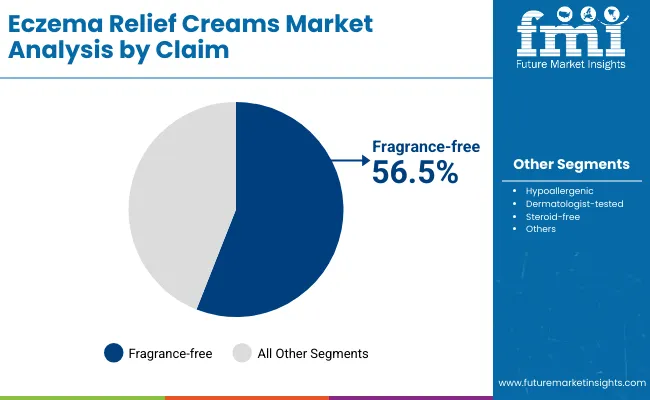
| Claim | Value Share% 2025 |
|---|---|
| Fragrance-free | 56.5% |
| Others | 43.5% |
The fragrance-free segment is projected to contribute 56.5% of the Eczema Relief Creams Market revenue in 2025, maintaining its lead as the dominant claim category. This leadership stems from growing consumer concerns about allergens, sensitivities, and irritation linked to artificial fragrances. Dermatologists increasingly recommend fragrance-free formulations for infants, children, and sensitive skin users, reinforcing consumer trust. The segment’s growth is further supported by the rising popularity of clean-label, hypoallergenic products across both pharmacies and e-commerce channels. As demand for safe and dermatologist-tested skincare accelerates, the fragrance-free category is expected to retain its position as the backbone of product innovation and consumer preference in eczema relief creams.
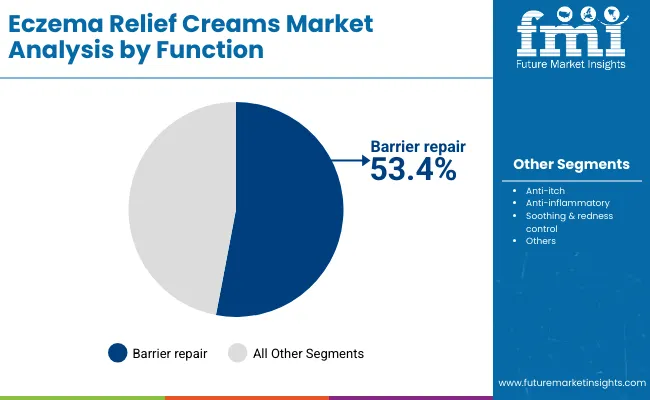
| Function | Value Share% 2025 |
|---|---|
| Barrier repair | 53.4% |
| Others | 46.6% |
The barrier repair segment is forecasted to hold 53.4% of the Eczema Relief Creams Market share in 2025, led by its critical role in restoring skin health and preventing flare-ups. Barrier repair formulations, often enriched with ceramides, colloidal oatmeal, and emollients, are favored by both dermatologists and consumers for their proven ability to strengthen the skin’s protective layer. Their effectiveness in managing chronic dryness, irritation, and sensitivity has made them the first line of defense for infants and adults alike.
The segment’s growth is further supported by innovations in prescription-grade and OTC barrier creams that combine hydration with anti-inflammatory properties. As demand for safe, long-term management options rises, barrier repair is expected to continue its dominance in the eczema relief creams market.
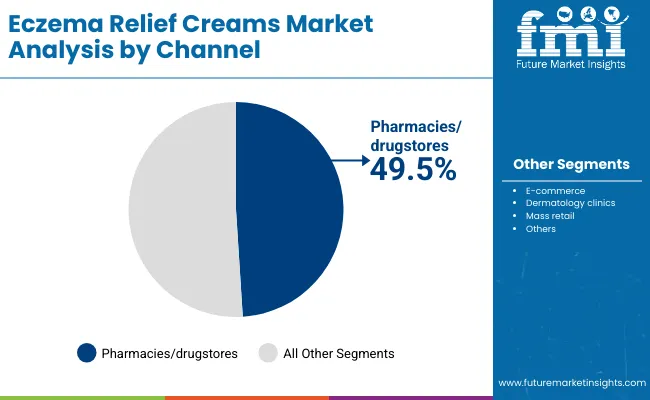
| Channel | Value Share% 2025 |
|---|---|
| Pharmacies/drugstores | 49.5% |
| Others | 50.5% |
The pharmacies/drugstores segment is projected to contribute 49.5% of the Eczema Relief Creams Market revenue in 2025, establishing it as the leading distribution channel. Pharmacies are preferred by consumers due to the trust associated with pharmacist recommendations, accessibility, and the wide availability of both OTC corticosteroid creams and prescription products. Their strong presence across urban and semi-urban areas makes them a reliable first point of purchase for eczema patients seeking immediate relief.
Growth is further supported by dermatologists directing patients to pharmacy outlets for clinically validated brands such as CeraVe, Aveeno, and Eucerin. As consumer confidence in professional guidance remains strong, pharmacies and drugstores are expected to retain their dominant role in the distribution of eczema relief creams.
Rising prevalence of eczema across age groups
The growing incidence of eczema among infants, children, and adults is a significant market driver. Lifestyle changes, urban pollution, allergens, and stress-related factors are increasing the number of patients requiring daily management solutions. This surge in cases is fueling demand for effective eczema relief creams that provide long-term symptom control. With dermatologists increasingly recommending OTC barrier-repair creams and corticosteroid-based formulations as first-line treatments, consumer adoption continues to rise, driving consistent revenue growth for both global and regional skincare brands.
Growing preference for fragrance-free and clean-label products
Consumer demand for safer, dermatologist-tested, and clean-label formulations is reshaping the market. Fragrance-free products dominate due to heightened awareness about allergies and irritants that can worsen eczema symptoms. Parents of infants and adults with sensitive skin are particularly inclined toward hypoallergenic and steroid-free claims. This has led major players such as CeraVe, Aveeno, and La Roche-Posay to expand their fragrance-free and natural ingredient offerings. The shift toward cleaner formulations not only enhances consumer trust but also supports premiumization within the market.
Safety concerns with prolonged corticosteroid use
While OTC corticosteroid creams are effective for managing eczema flare-ups, prolonged or unsupervised use raises safety concerns. Side effects such as skin thinning, irritation, and dependency risks limit their appeal for long-term treatment. These concerns often push patients and caregivers toward alternatives like barrier-repair creams or natural adjunctive therapies, slowing corticosteroid growth. Additionally, regulatory restrictions and heightened awareness about the potential harms of steroid misuse are challenging brands to innovate safer substitutes, posing a restraint to market expansion in certain consumer segments.
Expansion of e-commerce and D2C skincare brands
The rise of e-commerce platforms and direct-to-consumer (D2C) brands is transforming distribution in the eczema relief creams market. Online channels provide greater product accessibility, detailed claim-based filtering, and the opportunity for smaller brands to compete with established players. Consumers increasingly prefer digital purchasing for dermatologist-tested and niche products, especially in Asia-Pacific. Subscription-based models and personalized online consultations further enhance loyalty. This trend is allowing emerging players with clean-label and natural ingredient positioning to capture share rapidly, reshaping competition and accelerating global market penetration.

| Countries | Estimated CAGR (2025 to 2035) |
|---|---|
| China | 20.2% |
| USA | 8.6% |
| India | 22.7% |
| UK | 12.7% |
| Germany | 10.3% |
| Japan | 16.4% |
The global Eczema Relief Creams Market shows clear regional disparities in growth, strongly influenced by consumer demographics, healthcare access, and retail distribution strength. Asia-Pacific emerges as the fastest-growing region, led by India at 22.7% CAGR and China at 20.2% CAGR, driven by rising awareness of dermatological care, expanding middle-class populations, and strong e-commerce penetration. In India, affordability and increased dermatologist outreach are boosting prescription and OTC adoption, while China benefits from premium brand expansion and preference for fragrance-free creams. Japan also demonstrates robust momentum at 16.4% CAGR, supported by advanced skincare innovation and sensitive skin-focused formulations.
Europe maintains steady growth, with Germany at 10.3% CAGR and the UK at 12.7% CAGR, supported by high consumer awareness, regulatory emphasis on product safety, and strong presence of global dermatology brands. North America shows moderate expansion, with the USA at 8.6% CAGR, reflecting a mature but stable market where demand is reinforced by increasing preference for hypoallergenic and steroid-free claims. Regional performance underscores that while North America and Europe remain large revenue contributors, Asia-Pacific will be the primary engine of market acceleration through 2035.
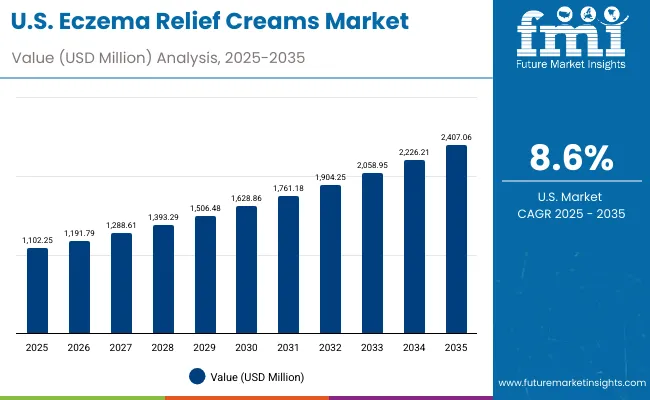
| Year | USA Eczema Relief Creams Market (USD Million) |
|---|---|
| 2025 | 1,102.25 |
| 2026 | 1,191.79 |
| 2027 | 1,288.61 |
| 2028 | 1,393.29 |
| 2029 | 1,506.48 |
| 2030 | 1,628.86 |
| 2031 | 1,761.18 |
| 2032 | 1,904.25 |
| 2033 | 2,058.95 |
| 2034 | 2,226.21 |
| 2035 | 2,407.06 |
The Eczema Relief Creams Market in the United States is projected to grow at a CAGR of 8.6% (2025-2035), led by rising awareness of eczema management, the strong presence of dermatology-recommended OTC brands, and growing adoption of fragrance-free and hypoallergenic formulations. Increasing cases of pediatric eczema and sensitive skin among adults are fueling demand for barrier-repair creams, while steroid-free and dermatologist-tested claims are driving premiumization. Pharmacies and drugstores remain the dominant distribution channel, though e-commerce penetration is rising rapidly due to convenience and product variety.
The Eczema Relief Creams Market in the United Kingdom is expected to grow at a CAGR of 12.7% (2025-2035), supported by rising demand for dermatologist-tested, fragrance-free, and steroid-free formulations. Increasing awareness of eczema management, along with strong consumer preference for hypoallergenic skincare, is boosting sales across pharmacies and mass retail outlets. The UK benefits from high healthcare access, government-backed awareness campaigns, and a mature retail infrastructure that enables wide product penetration. Premium European brands such as La Roche-Posay, Eucerin, and Bioderma maintain strong market presence, while local and private-label players expand through supermarkets and e-commerce platforms.
India is witnessing rapid growth in the Eczema Relief Creams Market, which is forecast to expand at a CAGR of 22.7% through 2035. Rising awareness of skin health and the growing prevalence of eczema across both urban and rural populations are driving demand for affordable and effective solutions. Tier-2 and Tier-3 cities are emerging as strong growth hubs due to cost-effective product launches and wider pharmacy access. International brands are expanding in premium urban segments, while local players are strengthening their presence with competitively priced emollients and herbal-based eczema relief creams. The increasing role of dermatologists and pediatricians in recommending fragrance-free and hypoallergenic products further fuels adoption across the country.
The Eczema Relief Creams Market in China is expected to grow at a CAGR of 20.2% (2025-2035), the highest among leading economies. This strong momentum is driven by rising consumer awareness of skin health, rapid expansion of e-commerce channels, and increasing demand for dermatologist-tested and fragrance-free formulations. China’s middle-class population is increasingly willing to invest in premium skincare, while domestic brands are competing with global players by offering competitively priced barrier-repair creams and herbal-based solutions. Urban centers lead demand, but Tier-2 and Tier-3 cities are quickly becoming growth engines due to digital retail penetration and growing pediatric eczema prevalence.
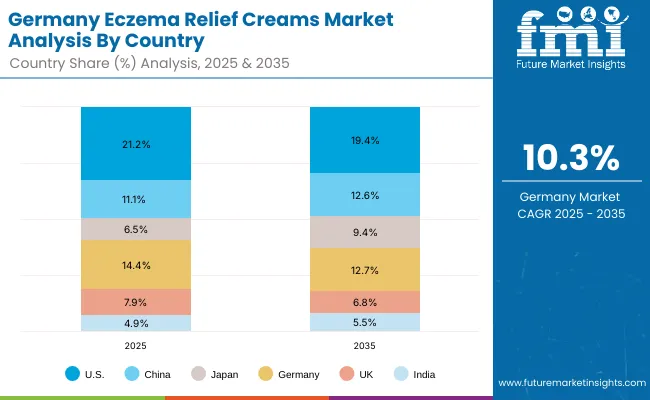
| Countries | 2025 Share (%) |
|---|---|
| USA | 21.2% |
| China | 11.1% |
| Japan | 6.5% |
| Germany | 14.4% |
| UK | 7.9% |
| India | 4.9% |
| Countries | 2035 Share (%) |
|---|---|
| USA | 19.4% |
| China | 12.6% |
| Japan | 9.4% |
| Germany | 12.7% |
| UK | 6.8% |
| India | 5.5% |
The Eczema Relief Creams Market in Germany is projected to grow at a CAGR of 10.3% (2025-2035), supported by strong consumer awareness, widespread dermatologist recommendations, and regulatory emphasis on safe, clinically validated skincare. German consumers demonstrate high trust in pharmacy and drugstore channels, where leading brands such as Eucerin, La Roche-Posay, and Bioderma dominate shelves. Demand is also rising for fragrance-free, steroid-free, and hypoallergenic formulations, particularly among families managing chronic eczema in children. Sustainability plays a pivotal role in shaping consumer choices, with growing preference for clean-label and eco-certified creams.

| USA by Claim | Value Share% 2025 |
|---|---|
| Fragrance-free | 57.4% |
| Others | 42.6% |
The Eczema Relief Creams Market in the United States is projected to grow steadily, supported by the strong dominance of fragrance-free formulations, which accounted for 57.4% of market value in 2025. Demand is driven by the high prevalence of eczema among both pediatric and adult populations, with consumers prioritizing hypoallergenic, steroid-free, and dermatologist-tested products. Pharmacies and drugstores remain the primary distribution channel, though e-commerce is gaining ground due to rising preference for online skincare purchases. Global brands such as CeraVe, Aveeno, and Cetaphil maintain strong visibility, while niche D2C players are entering with clean-label and natural alternatives.
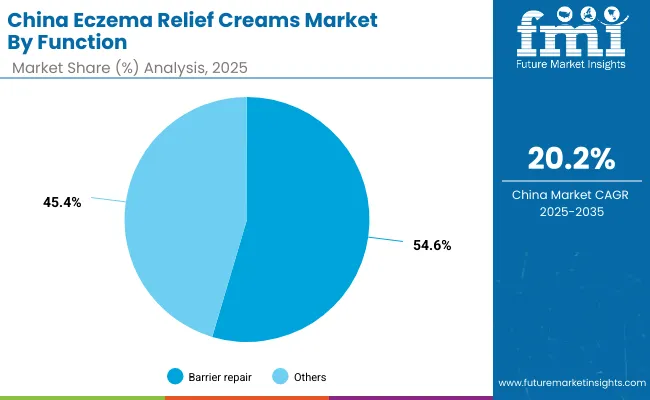
| China by Function | Value Share% 2025 |
|---|---|
| Barrier repair | 54.6% |
| Others | 45.4% |
The Eczema Relief Creams Market in China presents significant growth opportunities, expanding at a CAGR of 20.2% (2025-2035), the highest among leading global economies. Barrier repair products dominate, accounting for 54.6% of sales in 2025, driven by rising pediatric eczema cases and heightened demand for dermatologist-tested, fragrance-free formulations. E-commerce platforms are a major growth accelerator, enabling rapid penetration into Tier-2 and Tier-3 cities, where awareness of sensitive-skin care is climbing. Domestic brands are leveraging affordability and herbal-based positioning to compete with premium imports such as La Roche-Posay and CeraVe.
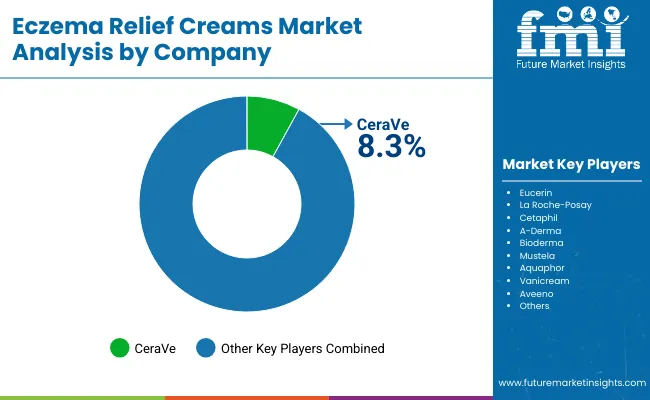
The Eczema Relief Creams Market is moderately fragmented, with global dermatology leaders, regional brands, and private-label players competing across diverse consumer groups. Global leaders such as CeraVe, Aveeno, Eucerin, La Roche-Posay, and Cetaphil hold significant market share, driven by clinically validated formulations, dermatologist endorsements, and strong retail penetration. Their strategies increasingly emphasize fragrance-free, steroid-free, and hypoallergenic claims, alongside expansions into e-commerce and subscription-based models.
Established mid-tier brands, including Bioderma, Mustela, and Aquaphor, focus on pediatric and sensitive skin care, strengthening their positions with barrier-repair and colloidal oatmeal-based formulations. These brands are accelerating adoption through pharmacist recommendations and targeted consumer education in both developed and emerging markets. Specialist and local players, including A-Derma and Vanicream, cater to niche needs with clean-label and natural positioning. Their strength lies in customized solutions and regional adaptability, particularly in markets such as Asia-Pacific where affordability and herbal alternatives are gaining momentum.
Competitive differentiation is shifting away from product efficacy alone toward brand ecosystems built on dermatologist trust, clinical validation, and sustainability positioning. With digital retail platforms reshaping consumer access, market leaders are investing in online-exclusive lines and direct-to-consumer strategies, while regional players compete through affordability and localized formulations.
Key Developments in Eczema Relief Creams Market
| Item | Value |
|---|---|
| Quantitative Units | USD 5,203.4 Million |
| Treatment Type | OTC emollients & barrier creams, OTC corticosteroid creams, Prescription topical (calcineurin/PDE4), Adjunctive therapies (colloidal oatmeal, probiotics) |
| Function | Barrier repair, Anti-itch, Anti-inflammatory, Soothing & redness control |
| Form | Cream, Ointment/balm, Lotion, Wash/cleanser |
| Channel | Pharmacies/drugstores, E-commerce, Dermatology clinics, Mass retail |
| End User | Infants & children, Adults, Sensitive skin users |
| Claim | Fragrance-free, Hypoallergenic, Dermatologist-tested, Steroid-free |
| Regions Covered | North America, Europe, Asia-Pacific, Latin America, Middle East & Africa |
| Country Covered | United States, Canada, Germany, France, United Kingdom, China, Japan, India, Brazil, South Africa |
| Key Companies Profiled | Aveeno, CeraVe, Eucerin, La Roche-Posay, Cetaphil, A-Derma, Bioderma, Mustela, Aquaphor, Vanicream |
| Additional Attributes | Dollar sales by treatment type and distribution channel, adoption trends in fragrance-free and hypoallergenic formulations, rising demand for pediatric-focused and barrier-repair creams, sector-specific growth in pharmacies, e-commerce, and dermatology clinics, revenue segmentation by claim type (fragrance-free, steroid-free, dermatologist-tested), integration of natural adjunctive ingredients such as colloidal oatmeal and probiotics, regional growth dynamics driven by Asia-Pacific double-digit CAGR, and innovation in clean-label, steroid-free, and sensitive-skin formulations. |
The global Eczema Relief Creams Market is estimated to be valued at USD 5,203.4 million in 2025.
The market size for the Eczema Relief Creams Market is projected to reach USD 12,403.7 million by 2035.
The Eczema Relief Creams Market is expected to grow at a 9.1% CAGR between 2025 and 2035.
The key form types in the Eczema Relief Creams Market are creams, ointments/balms, lotions, and wash/cleansers.
In terms of function, the barrier repair segment is expected to command the largest share in 2025, accounting for 53.4% of market value.






Our Research Products

The "Full Research Suite" delivers actionable market intel, deep dives on markets or technologies, so clients act faster, cut risk, and unlock growth.

The Leaderboard benchmarks and ranks top vendors, classifying them as Established Leaders, Leading Challengers, or Disruptors & Challengers.

Locates where complements amplify value and substitutes erode it, forecasting net impact by horizon

We deliver granular, decision-grade intel: market sizing, 5-year forecasts, pricing, adoption, usage, revenue, and operational KPIs—plus competitor tracking, regulation, and value chains—across 60 countries broadly.

Spot the shifts before they hit your P&L. We track inflection points, adoption curves, pricing moves, and ecosystem plays to show where demand is heading, why it is changing, and what to do next across high-growth markets and disruptive tech

Real-time reads of user behavior. We track shifting priorities, perceptions of today’s and next-gen services, and provider experience, then pace how fast tech moves from trial to adoption, blending buyer, consumer, and channel inputs with social signals (#WhySwitch, #UX).

Partner with our analyst team to build a custom report designed around your business priorities. From analysing market trends to assessing competitors or crafting bespoke datasets, we tailor insights to your needs.
Supplier Intelligence
Discovery & Profiling
Capacity & Footprint
Performance & Risk
Compliance & Governance
Commercial Readiness
Who Supplies Whom
Scorecards & Shortlists
Playbooks & Docs
Category Intelligence
Definition & Scope
Demand & Use Cases
Cost Drivers
Market Structure
Supply Chain Map
Trade & Policy
Operating Norms
Deliverables
Buyer Intelligence
Account Basics
Spend & Scope
Procurement Model
Vendor Requirements
Terms & Policies
Entry Strategy
Pain Points & Triggers
Outputs
Pricing Analysis
Benchmarks
Trends
Should-Cost
Indexation
Landed Cost
Commercial Terms
Deliverables
Brand Analysis
Positioning & Value Prop
Share & Presence
Customer Evidence
Go-to-Market
Digital & Reputation
Compliance & Trust
KPIs & Gaps
Outputs
Full Research Suite comprises of:
Market outlook & trends analysis
Interviews & case studies
Strategic recommendations
Vendor profiles & capabilities analysis
5-year forecasts
8 regions and 60+ country-level data splits
Market segment data splits
12 months of continuous data updates
DELIVERED AS:
PDF EXCEL ONLINE
Hand Eczema (HE) Treatment Market Overview - Growth, Demand & Forecast 2025 to 2035
Cold Relief Roll-On Market Analysis by Application, Distribution Channel, and Region through 2035
Stress-Relief Skincare Market Size and Share Forecast Outlook 2025 to 2035
Stress Relief Supplement Market Analysis by Source, Form, Category and Distribution Channel Through 2035
Redness-Relief Skincare Market Size and Share Forecast Outlook 2025 to 2035
Sunburn Relief Products Market Size and Share Forecast Outlook 2025 to 2035
Pressure Relief Dressing Market Size and Share Forecast Outlook 2025 to 2035
Disaster Relief Logistics Market Size and Share Forecast Outlook 2025 to 2035
Pressure Relief Valve Market Size and Share Forecast Outlook 2025 to 2035
Pressure Relief Valve (PRV) Market
Itchy Skin Relief Lotions Market Size and Share Forecast Outlook 2025 to 2035
Global Topical Pain Relief Market Insights – Size, Trends & Forecast 2024-2034
Firming Creams and Serums Market Analysis - Size and Share Forecast Outlook 2025 to 2035
Slugging Creams Market Size and Share Forecast Outlook 2025 to 2035
Anti-Aging Creams & Serums Market Size and Share Forecast Outlook 2025 to 2035
Anti-Wrinkle Creams Market Size and Share Forecast Outlook 2025 to 2035
Body Firming Creams Market Growth & Forecast 2025-2035
Muscle Relaxing Creams Market Size and Share Forecast Outlook 2025 to 2035
Plant-Based Ice Creams Market Analysis by Form, Product Type, Flavor, Source, Sales Channel, and Region through 2035
Moisturizing Body Creams Market Size and Share Forecast Outlook 2025 to 2035

Thank you!
You will receive an email from our Business Development Manager. Please be sure to check your SPAM/JUNK folder too.
Chat With
MaRIA